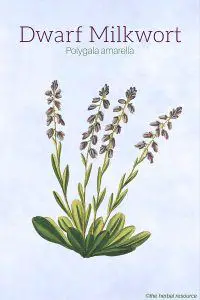The main ingredients consist of triterpene saponins, a bitter substance (polygamarin), tannins and essential oils with salicylates.
Dwarf milkwort has similar medical properties as its related species, common milkwort (Polygala vulgaris) and senega root (Polygala senega).
Due to the saponins and bitter substances found in the plant, it has expectorant and diuretic properties and stimulates the secretion of digestive fluids and appetite.
Polygala amarella is often used in the form of a decoction or powder, sometimes in combination with other herbs for treating coughs, bronchitis and other infections of the upper respiratory tract.
Dwarf milkwort is used to treat asthma, but it’s considered much less effective than senega root (Polygala Senega) in that regard.
The powdered root has also been recommended for kidney disease, dropsy (edema), gout, poor appetite and digestive problems like diarrhea.
The genus name Polygala comes from the Greek words “poly” (much or many) and “gala” (milk) and reflects that species in this genus were used in herbal folk medicine to increase milk production in humans as well as livestock. It’s still not scientifically proven whether the herb really has this alleged ability.
The species name amarella is a diminutive form of the Latin word “amarus” (bitter or harsh), and therefore, the name means “slightly bitter taste”, which explains the other English name the plant is known by – bitter milkwort.
[Read more about Dwarf Milkwort…]

Leave a Reply